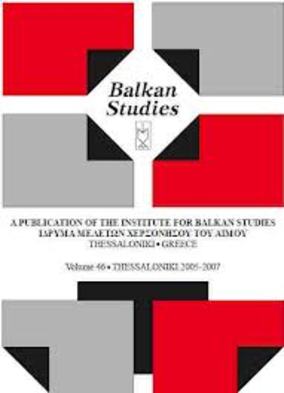Transport geography and local development in Thrace during the19th century
Part of : Balkan studies : biannual publication of the Institute for Balkan Studies ; Vol.40, No.2, 1999, pages 281-307
Issue:
Pages:
281-307
Section Title:
Articles
Author:
Abstract:
The process of development of Thrace during the 19th century, in thescientific framework of Historical Regional Geography and Transport Geography,is the main topic of the following essay.This viewpoint is historically interesting, since during that period thecrumbling Ottoman Empire played a double socio-economic role. On one handis functioned as an exploitative and dominating force in the Balkans through the Ottoman feudal system, while on the other it functioned as a semi-colonialregional force in relation to the powerful capitalistic European countries(mainly Great Britain, France, etc.).Moreover, it is theoretically interesting, because it refers to the way inwhich a “virtual development” was created in the context of the introduction ofEuropean capitalism in a feudal environment. This introduction was alsoencouraged by the use of innovative forces, such as the railway, which was thenew technology of that period.The spread of development in the specific geographic region (settlementspace) of Thrace is methodologically interesting due to the use or function ofinternal or external factors. Five factors, complementary to each other, arelocated, which relate to the phenomenon of the spread of development in thegeographic region. The three basic factors, which are of interest to HumanGeography because they are determined by and for society (internally orexternally) are the following: (i) the socio-economic structure, which is spatiallydifferentiated, (ii) the settlement space, and (iii) the transport network. Twosecondary factors which are: (iv) the geopolitical structure, a particularly unstablefactor in the 19th century and (v) the geographic space, which restrained(positively, negatively or neutrally) the development of the remaining factors(e.g. the settlement space, the transport network etc.).The aim of this essay is to locate the zones of potential development inhomogenous geographic units. The grouping or categorization of the zones isachieved by a table of their assessment (table 1). The table in the verticalcolumns includes the four factors of the supposed local development, whichwere mentioned above. These are: geopolitical, geographic, socio-economicand settlement structure, as they are differentiated in each zone with a positive,neutral or negative impact.Simultaneously the fifth factor is also assessed, that is the transportnetwork, the impact of which on development is estimated both before andafter 1870 (when the railway was established). The last factor shows thegeometrical proximity of every zone on the basis of the total transport systemwith an emphasis on the railway. The assessment (+, 0, -) of the factors in thevertical columns is done empirically and comparatively for each case (table 1).The horizontal reading of the five factors gives us the total importance ofthe factors of the evaluation, on the basis of which the factors can be groupedinto less or more developed. The result of the final assessment, vertically andhorizontally, is the definition and description of the homogenous developmentzones in Thrace during the 19th century. Nine new zones of developmentappear (map 1). According to the data of assessment, zones number 7, 8, 9 follow the process of development positively (+), whereas the opposite is thecase with zones number 2, 4, 6, which are still not developed (-). The rest ofthe zones are between these categories (towards + or -).Meanwhile, some other conclusions could be drawn, which lead to thegeneral view that the attempt at the modernization of transport in Thrace bythe Ottoman state (external cause) towards the end of the 19th century did notresult in the expected modernization of the settlement space, due to internaland, partly external causes, which were determined by the factors of localdevelopment. These causes had an important impact on the settlement space ofThrace in the 19th century.
Subject:
Subject (LC):
Keywords:
Η Θράκη τον 19ο αιώνα




